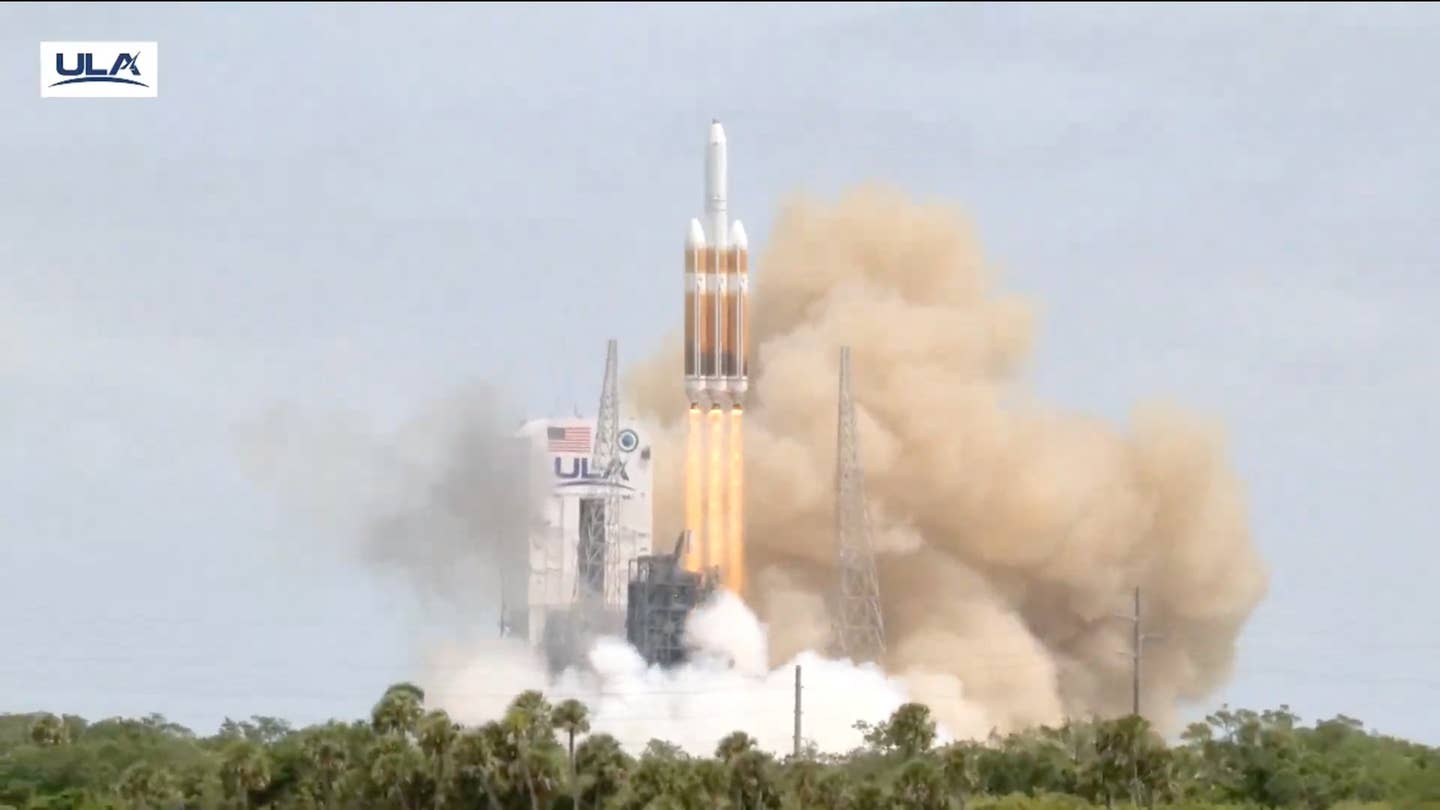Prolific Delta IV Heavy Launcher Makes Final Flight
Delta IV Heavy played a key role in U.S. space initiatives, launching Martian rovers, ‘sun-touching’ probes, and a bevy of other cargo into space.

United Launch Alliance’s Delta IV Heavy space launch vehicle takes off for the final time. [Courtesy: United Launch Alliance]
One of America’s most powerful and expensive commercially made space launch vehicles is flying into the sunset.
Tuesday marked the swan song for Delta IV Heavy, a heavy-lift launcher headed for retirement. The spacecraft was built by United Launch Alliance (ULA)—a joint venture between Lockheed Martin and Boeing—and is considered one of the most prolific in U.S. history.
Delta IV Heavy, standing 235 feet tall, is part of ULA’s Delta family of rockets, which along with its Atlas family is used primarily by the U.S. government. Tuesday’s launch was conducted in partnership with the National Reconnaissance Office (NRO), which is responsible for designing, building, launching and maintaining U.S. intelligence satellites.
The mission, NROL-70, is ULA’s 35th for the NRO and 99th for U.S. national security. Its payload is classified.
NROL-70 also represented the 389th Delta launch since 1960 and the 294th to lift off from Cape Canaveral Space Force Station in Florida. It was ULA’s 45th and final launch of a Delta IV rocket and its 16th in the Heavy configuration.
ULA is in the process of transitioning launches from Cape Canaveral and Vandenburg Space Force Base in California to its Vulcan Centaur, the successor to Delta and eventually Atlas. Vulcan completed its maiden voyage in January, carrying a Peregrine lunar lander for commercial customer Astrobotic.
On Tuesday morning, teams at Cape Canaveral reported 90 percent favorable conditions for the launch, which was originally scheduled for March 28. Crews promptly began filling the rocket’s eight cryogenic tanks with 470,000 gallons of supercooled liquid oxygen and liquid hydrogen.
The tanks power the spacecraft’s three common core boosters, which fuel three RS-68A engines each producing 700,000 pounds of thrust at sea level. The RS-68A is the largest hydrogen-burning engine in existence, per ULA.
The tanks also fuel Delta IV Heavy’s Delta Cryogenic Second Stage (DCSS), which is powered by a single RL10C-2-1 engine producing nearly 25,000 pounds of thrust. The DCSS avionics system provides guidance and flight control for the booster.
At 12:24 p.m. EST, ULA received confirmation that weather conditions were “green.” Minutes later, NRO mission director Colonel Eric Zarybnisky gave the final “go” for launch.
ULA began pressurizing the rocket’s tanks and started the launcher sequence, which independently verifies systems are functioning during the remainder of the countdown. Those systems include the hydrogen burnoff igniters beneath the engine, which play a critical role during launch.
Liftoff took place at 12:53 p.m., exactly as planned, enshrouding the launch pad in a ball of fire. That was also planned—Delta IV uses hydrogen gas to cool the rocket down before takeoff, which ignites and burns off during launch. A staggered engine ignition mitigates this process and reduces the burnoff.
After clearing the launch tower for the final time, the rocket could be seen across most of the Florida peninsula, barring cloud cover. About 1 minute and 30 seconds into the flight, Delta IV Heavy broke the sound barrier. One minute after that, it weighed just half what it did at takeoff due to the amount of fuel it must consume.
By the time the booster core and DCSS separated about six minutes into the mission, Delta IV Heavy was traveling 15 times the speed of sound. A few seconds later, the rocket reached space, and ULA ended its coverage.
“For the final time, this is Delta Launch Control, signing off,” ULA said.
At the time of its retirement, Delta IV Heavy is the third-highest capacity launch vehicle in operation, after NASA’s Space Launch System (SLS) and SpaceX’s Falcon Heavy.
Delta rockets have ferried NASA’s Spirit and Opportunity rovers and other missions to Mars, launched probes that “touched the sun,” and even carried out the first orbital test flight of NASA’s Orion capsule. Orion will ferry astronauts around the moon and back during NASA’s Artemis II mission in 2025.
Delta’s successor, Vulcan, is less expensive than both it and Atlas V, the most recent addition to the Atlas family. It is designed primarily for the National Security Space Launch program. But ULA is also collaborating Vulcan launches with Amazon’s Project Kuiper and other commercial customers.
ULA’s new flagship spacecraft will need to compete with SpaceX’s Falcon 9 and Falcon Heavy launch vehicles, which unlike Vulcan are reusable. The company also has 17 remaining launches for Atlas V, the country’s longest-serving active rocket.
Like this story? We think you'll also like the Future of FLYING newsletter sent every Thursday afternoon. Sign up now.

Subscribe to Our Newsletter
Get the latest FLYING stories delivered directly to your inbox






